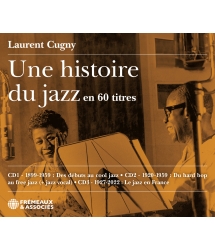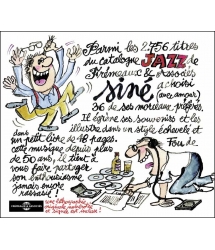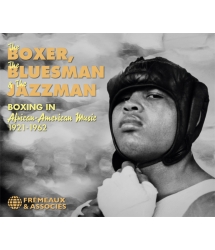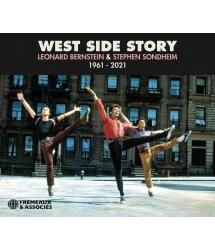- Our Catalog
- Philosophy
- Philosophers of the 20th century and today
- History of Philosophy (PUF)
- Counter-History and Brief Encyclopedia by Michel Onfray
- The philosophical work explained by Luc Ferry
- Ancient thought
- Thinkers of yesterday as seen by the philosophers of today
- Historical philosophical texts interpreted by great actors
- History
- Books (in French)
- Social science
- Historical words
- Audiobooks & Literature
- Our Catalog
- Jazz
- Blues
- Rock - Country - Cajun
- French song
- World music
- Africa
- France
- Québec / Canada
- Hawaï
- West Indies
- Caribbean
- Cuba & Afro-cubain
- Mexico
- South America
- Tango
- Brazil
- Tzigane / Gypsy
- Fado / Portugal
- Flamenco / Spain
- Yiddish / Israel
- China
- Tibet / Nepal
- Asia
- Indian Ocean / Madagascar
- Japan
- Indonesia
- Oceania
- India
- Bangladesh
- USSR / Communist songs
- World music / Miscellaneous
- Classical music
- Composers - Movie Soundtracks
- Sounds of nature
- Our Catalog
- Youth
- Philosophy
- News
- How to order ?
- Receive the catalog
- Manifesto
- Dictionnary











- Our Catalog
- Philosophy
- Philosophers of the 20th century and today
- History of Philosophy (PUF)
- Counter-History and Brief Encyclopedia by Michel Onfray
- The philosophical work explained by Luc Ferry
- Ancient thought
- Thinkers of yesterday as seen by the philosophers of today
- Historical philosophical texts interpreted by great actors
- History
- Books (in French)
- Social science
- Historical words
- Audiobooks & Literature
- Our Catalog
- Jazz
- Blues
- Rock - Country - Cajun
- French song
- World music
- Africa
- France
- Québec / Canada
- Hawaï
- West Indies
- Caribbean
- Cuba & Afro-cubain
- Mexico
- South America
- Tango
- Brazil
- Tzigane / Gypsy
- Fado / Portugal
- Flamenco / Spain
- Yiddish / Israel
- China
- Tibet / Nepal
- Asia
- Indian Ocean / Madagascar
- Japan
- Indonesia
- Oceania
- India
- Bangladesh
- USSR / Communist songs
- World music / Miscellaneous
- Classical music
- Composers - Movie Soundtracks
- Sounds of nature
- Our Catalog
- Youth
- Philosophy
- News
- How to order ?
- Receive the catalog
- Manifesto
- Dictionnary
TREME BRASS BAND - LIONEL BATISTE - KERMIT RUFFIN
Ref.: FA581
EAN : 3448960258128
Artistic Direction : GARY EDWARDS
Label : Frémeaux & Associés
Total duration of the pack : 44 minutes
Nbre. CD : 1
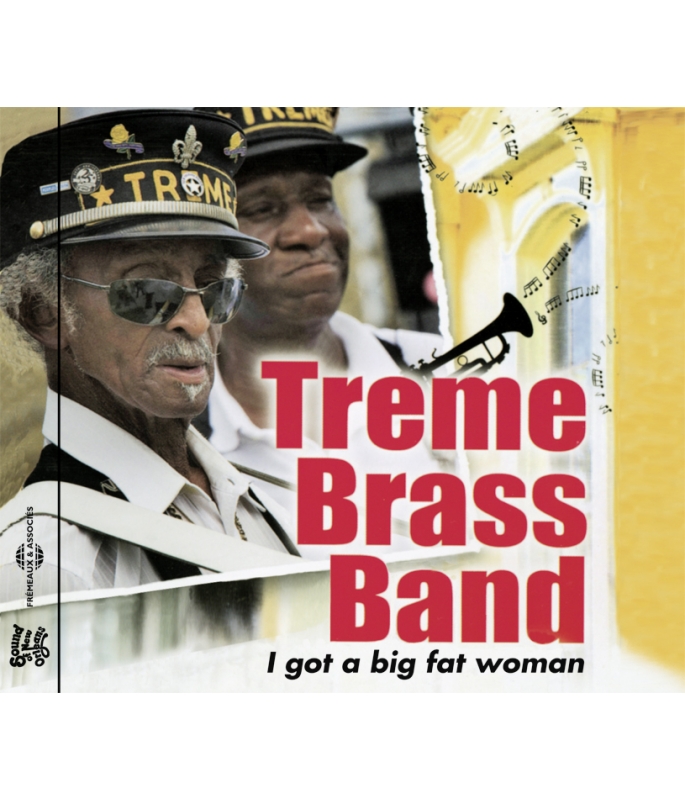
TREME BRASS BAND - LIONEL BATISTE - KERMIT RUFFIN
TREME BRASS BAND - LIONEL BATISTE - KERMIT RUFFIN
“If you ever wanted to hear the “real thing” in New Orleans street parade tradition, now is your chance. The Treme Brass Band recorded this album with the kind of abandon and happiness that one does not usually get to hear on record. The eight musicians and Mr. Youngblood were all together in the studio, no headphones, just listening to each other and having a great time. The Tremé Brass Band is rapidly becoming the brass band of choice in New Orleans. No matter how technically proficient one is at their instrument, nothing replaces the “Street beat” feeling, and the Tremé gives you that feeling every time! This is classic, funky New Orleans brass-band music recorded live in the studio, and just one listen will easily demonstrate why the National Endowment for the Arts named the Tremé Brass Band a national treasure.” Gary EDWARDS
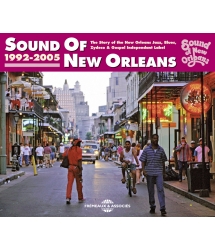
THE STORY OF THE NEW ORLEANS JAZZ, BLUES, ZYDECO &...
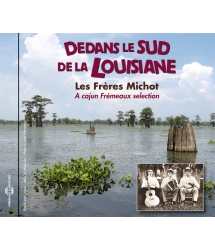
LES FRERES MICHOT
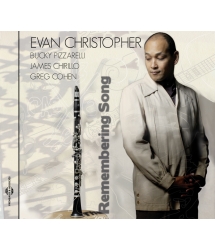
EVAN CHRISTOPHER



-
PisteTitleMain artistAutorDurationRegistered in
-
1I Got A Big Fat WomanBenny Jones/Lionel Batiste/Kenneth Terry/RevertAndrews/Eddie Paris/Kerwin James/Butch Gomez/Frédérik Sheppard/Henry YoungbloodH. Youngblood00:04:561990
-
2All Of MeBenny Jones/Lionel Batiste/Kenneth Terry/RevertAndrews/Eddie Paris/Kerwin James/Butch Gomez/Frédérik Sheppard/Henry YoungbloodG. Marks00:05:491990
-
3A Monday DateBenny Jones/Lionel Batiste/Kenneth Terry/RevertAndrews/Eddie Paris/Kerwin James/Butch Gomez/Frédérik Sheppard/Henry YoungbloodEarl Hines00:03:071990
-
4I Found A New BabyBenny Jones/Lionel Batiste/Kenneth Terry/RevertAndrews/Eddie Paris/Kerwin James/Butch Gomez/Frédérik Sheppard/Henry YoungbloodJ. Palmer00:04:091990
-
5Back Of Town BluesBenny Jones/Lionel Batiste/Kenneth Terry/RevertAndrews/Eddie Paris/Kerwin James/Butch Gomez/Frédérik Sheppard/Henry YoungbloodLouis Armstrong00:07:131990
-
6Grazin In The GrassBenny Jones/Lionel Batiste/Kenneth Terry/RevertAndrews/Eddie Paris/Kerwin James/Butch Gomez/Frédérik Sheppard/Henry YoungbloodH. Elston00:05:391990
-
7I'll Be Glad When You're Dead (You Rascal You)Benny Jones/Lionel Batiste/Kenneth Terry/RevertAndrews/Eddie Paris/Kerwin James/Butch Gomez/Frédérik Sheppard/Henry YoungbloodS. Theard00:04:021990
-
8Darktown Strutters BallBenny Jones/Lionel Batiste/Kenneth Terry/RevertAndrews/Eddie Paris/Kerwin James/Butch Gomez/Frédérik Sheppard/Henry YoungbloodS. Theard00:06:351990
-
9What A Wonderfull WorldBenny Jones/Lionel Batiste/Kenneth Terry/RevertAndrews/Eddie Paris/Kerwin James/Butch Gomez/Frédérik Sheppard/Henry YoungbloodG.D. Weiss00:02:551990
Treme Brass Band FA581
Tremé Brass Band
I got a big fat woman
1. I GOT A BIG FAT WOMAN (H. Youngblood) 4’56
2. ALL OF ME (G. Marks - S. Simons) 5’49
3. A MONDAY DATE (E. Hines) 3’07
4. I FOUND A NEW BABY (J. Palmer - S. Williams) 4’09
5. BACK OF TOWN BLUES (L. Armstrong - L. Russell) 7’13
6. GRAZIN’ IN THE GRASS (H. Elston - P. Hou) 5’39
7. I’LL BE GLAD WHEN YOU’RE DEAD (YOU RASCAL YOU) (S. Theard) 4’02
8. DARKTOWN STRUTTERS’ BALL (S. Brooks) 6’35
9. WHAT A WONDERFUL WORLD (G.D. Weiss - B. Thiele) 2’55
10. SAINTS / MAMA DON’T ALLOW (Trad.) 6’43
Benny Jones, Sr (snare drum, lead)
Lionel Batiste (bass drum, vocal on 5)
Kenneth Terry (trumpet, vocal on 7, 8, 10)
Revert Andrews (trombone)
Eddie “Boh“ Paris (trombone, vocal on 2, 3, 10)
Kerwin James (tuba)
Butch Gomez (soprano sax)
Frederick Sheppard (tenor sax)
Henry Youngblood (vocal on 1)
Recorded on July 28, 1990 at Sound Of New Orleans Studio
Engineers : Gary Edwards & Louie Ludwig
Notes by Jean Buzelin, Gary J. Edwards, Roger Hahn
Produced by Gary Edwards for sound of New Orleans and licensed to Frémeaux & Associés
Manufactured and distributed by Groupe Frémeaux Colombini SAS
Photos by Jules & Patrick Frémeaux (Thanks to Evan Christopher)
En mémoire de Lionel Batiste
Just A Closer Walk With Thee (Simplement marcher plus près de toi)… une fanfare précède un cortège funèbre qui s’avance dans les rues du quartier Tremé, à la Nouvelle-Orléans. La scène se déroule à la fin du premier épisode de la série télévisée du même nom, «?TREME?», diffusée sur les écrans américains par la chaîne HBO en avril 2010.
En tête de la procession, un petit bonhomme barbichu porte sur son ventre une grosse caisse qui a l’air presque plus volumineuse que lui, et sur laquelle il martèle consciencieusement le rythme lancinant de la marche lente. Il s’appelle Lionel Batiste et va sur ses 80 ans. C’est l’une des grandes figures des brass bands néo-orléanais. Né le 1er février 1931 dans la Cité du Croissant, il joue de la batterie depuis son enfance. Plus tard, il est devenu grand marshall, c’est-à-dire meneur de fanfare, sorte de tambour-major en redingote et chapeau melon qui porte l’écharpe aux couleurs de la formation et indique les pas cadencés sur lesquels les musiciens se calent. Il menait ainsi le Chosen Few Brass Band, lorsqu’il entre, en 1985, dans le déjà mondialement célèbre Dirty Dozen Brass Band pour y tenir la grosse caisse. Cette année-là, il tourne en Europe avec le groupe qui enregistre un disque au Festival de Montreux. Son partenaire Benny Jones, qui a fondé cet orchestre, l’entraîne alors dans le Tremé Brass Band dont il a pris la tête. Et pendant une dizaine d’années, Lionel Batiste va faire le va-et-vient entre les deux fanfares, la seconde n’ayant alors qu’une réputation locale. En 1995, il en devient définitivement un membre régulier.
Lorsque survient l’ouragan Katrina, en août 2005, “Uncle” Lionel aurait, aux dires du clarinettiste Michael White, grimpé à califourchon sur sa grosse caisse pour échapper à la noyade !
Lionel Batiste, qui avait également enregistré un disque sous son nom, «?Uncle Lionel?», en petite formation, a fait, le 8 juillet 2012, le pas de côté définitif, laissant ses compagnons lui offrir à son tour un ultime Just A Closer Walk With Thee…
Tremé et son brass band
Tremé est un quartier du 6e arrondissement de la Nouvelle-Orléans situé au nord-ouest du Vieux Carré, le French Quarter, entre Canal et Esplanade Streets, en plein centre de la ville. C’est l’un des plus anciens quartiers noirs du pays, là où autrefois, les Noirs libres se retrouvaient?; un endroit haut en couleur et un peu risqué, un lieu fondateur des cultures afro-américaines et créoles.
Au moment de la renaissance des brass bands au début des années 70 — leur histoire était plus que centenaire — un orchestre de rue (marching band) s’est constitué dans ce quartier sous la baguette de Benny Jones. En 1990, ce Tremé Brass Band est la première fanfare à être enregistrée par Gary Edwards pour son label Sound Of New Orleans (SONO)?; le CD sera publié en 1992 (1). Autour de Jones et de Batiste aux rythmes, se retrouve un ensemble de musiciens, certains chevronnés, d’autres plus jeunes et talentueux comme le saxophoniste Butch Gomez, qu’on retrouvera ensuite dans le Smitty Dee’s Brass Band, et le tromboniste et chanteur Eddie “Boh“ Paris, venu du Chosen Few et qui fondera plus tard son Funky 7 Brass Band (2). Lors de cet enregistrement en direct, le Tremé recevait un invité de marque en la personne d’Henry Youngblood qui chante I Got A Big Fat Woman. Depuis, cette chanson est devenue le “tube” de l’orchestre, réclamé à chacune de leurs apparitions.
Groupe déjà très «?professionnel?» mais qui a conservé l’enthousiasme des amateurs, le Tremé Brass Band se muscle encore dans les années suivantes, avec l’arrivée des trompettistes Kermit Ruffins (venu du ReBirth Jazz Band) et James Andrews, des saxophonistes Frederic Kemp et Elliot Callier, anciens de l’orchestre de Fats Domino, du trombone Corey Henry, et de deux autres transfuges du Dirty Dozen, le formidable tubiste Kirk Joseph et le saxophone Roger Lewis. Un second CD, regroupant des enregistrements de 1993 et 95, est alors publié par Arhoolie.
Ces dernières années, à côté de leurs prestations régulières et remarquées lors des fêtes, des cérémonies et des parades du Mardi-Gras qui, suite au désastre de Katrina, ont repris tant bien que mal, le Tremé Brass Band a ouvert en 2006 le National Endowment for the Arts?; cette prestigieuse institution lui décerne à cette occasion un National Heritage Fellows. En 2010, il participe donc à l’aventure télévisuelle de «?Tremé?» (3), et l’année suivante apparaît dans film «?Tradition of Temple?» de Darren Hoffman.
Tremé et sa musique
Le Tremé Brass Band, comme toutes les autres jeunes formations du même genre, ne se con-tente pas d’égrainer les vieux «?saucissons?» destinés aux touristes qui visitent la Nouvelle-Orléans. Sans s’écarter de la grande tradition musicale, sans oublier la figure éternellement présente de Louis Armstrong (Back O’ Town Blues, Wonderful World), ils ont intégré le rhythm and blues de la ville (I Got A Big Fat Woman), reprennent et habillent à leur manière des thèmes de jazz venus d’autres horizons (All Of me, Monday Date) et même des succès populaires comme Grazin’ In The Grass qui, joué par le trompettiste sud-africain Hugh Masekela, fut N°1 au Billboard Hot 100 en 1968. Tous ces airs se parent de couleurs uniques et sont broyés, malaxés, parfumés, pimentés en un inimitable gumbo qui fait toute la saveur de la musique néo-orléanaise.
Grâce aux musiciens du Tremé Brass Band (et des autres fanfares sœurs), cette musique traverse le temps et rassemble les générations. Elle a contribué au redressement, à la reconstruction et à la renaissance de la ville, et porte haut et fort les sons colorés et épicés sans lesquels le jazz n’aurait pas existé.
Longue vie à Tremé, son quartier, ses musiciens, ses habitants.
Jean BUZELIN
© 2013 FRÉMEAUX & ASSOCIÉS
(1) À écouter : Sound Of New Orleans 1992-2005 (FA 5223), qui propose un panorama de tout le catalogue.
(2) À écouter : New Orleans Brass Bands (à paraître chez Frémeaux & Associés).
(3) Tournée sur les lieux de la catastrophe, la série «?TREME?» imaginée par David Simon et Eric Overmyer (qui avaient déjà concocté «?The Wire?») est sensée se dérouler trois mois après l’ouragan, alors que la ville dévastée panse ses plaies et ne sait pas encore par quels bouts attaquer la reconstruction. À travers plusieurs histoires qui se chevauchent ou se recoupent, le feuilleton donne une large place aux musiciens de la ville, du légendaire Dave Bartholomew, qui souffle dans sa trompette à 90 ans, jusqu’à la star montante Troy Andrews dit Trombone Shorty. Apparaissent ainsi au gré des épisodes des «?gloires?» comme Allen Toussaint, Irma Thomas, Lloyd Price, Dr John, Clarence “Frogman“ Henry, les Neville Brothers… ainsi que de jeunes jazzmen comme Terence Blanchard et Donald Harrison, et bien évidemment les brass bands (Dirty Dozen, Hot 8, ReBirth, Soul Rebels et Tremé) et leurs musiciens dont Kermit Ruffins ou James Andrews. Parmi les acteurs, on relève les noms de Clarke Peters, Khandi Alexander, Melissa Leo, John Goodman… et Wendell Pierce (natif de la ville) qui, dans le rôle d’un tromboniste appelé Antoine Batiste, défile aux côtés de son ami Lionel ! Diffusés aux Etats-Unis d’avril à juin 2010, les dix premiers épisodes l’ont été sur la chaîne nationale France Ô à partir de janvier 2012 (en VF hélas, heureusement sauf les chansons). Une deuxième saison a été programmée Outre-Atlantique entre avril et juillet 2011, et une troisième a débuté en septembre 2012.
The New Orleans tradition of a street parade marching band is tied to the custom of honouring the passing of a friend. The solemn dirges are played on the way to the cemetery and the loved one’s passing is sadly mourned. After the parade leaves the cemetery, the “second liners” follow the band and dance to celebrate the memory of the departed one. He is said to be relieved of all his cares and woes, and he has left a beautiful memory in the hearts of those he left here on this earth. The marching bands of New Orleans still the funerals, but they also play for festive occasions also. No celebration in New Orleans would be complete without a marching band to lead the “second line” dancers, umbrellas, handkerchiefs and lots of excitement.
If you ever wanted to hear the “real thing” in New Orleans street parade tradition, now is your chance. THE TREME BRASS BAND recorded this album with the kind of abandon and happiness that one does not usually get to hear on record. The eight musicians and Mr. Youngblood were all together in the studio, no headphones, just listening to each other and having a great time. The TREME BRASS BAND is rapidly becoming the brass band of choice in New Orleans. No matter how technically proficient one is at their instrument, nothing replaces the “Street beat” feeling, and the TREME gives you that feeling every time!
Gary J. EDWARDS
SOUNDS OF NEW ORLEANS
Just how good is the Treme Brass Band? Good enough to be named 2006 National Heritage Fellows by the National Endowment for the Arts.
Anchored by snare drummer Benny Jones, the band’s leader, and bass drummer “Uncle” Lionel Batiste – the sharpest looking septuagenarian you’ll ever met – the band is named for the Treme neighbourhoods in the country and a real haven for brass-band music. Snare drummer Jones and bass drummer Batiste were both founding members of the Dirty Dozen Brass Band a quarter-century ago, but neither wanted to tour full-time, so they formed a stay-at-home band that has become a kind of “finishing school” for an entire generation of up-and-coming New Orleans brass band musicians.
And on any given night in a backstreet barroom, a Treme Brass Band set can take you almost anywhere, from classic jazz, like “All of Me” or “Darktown Strutters Ball”, to hip classic, like the Hugh Massekela hit, “Grazin’ in the Grass”.
And the band can be really tear it up, with extended jams and virtuoso solos their specialties, on classic brass-band repertoire, like “I found a New Baby” or the hilarious “I’ll Be Glad When You’re Dead (You Rascal, You)”. They can swing the pants of audience favourites, too, like “Wonderful World” or a spirited “When the Saints/Mama Don’t Allow” medley.
This is classic, funky New Orleans brass-band music recorded live in the studio, and just one listen will easily demonstrate why the National Endowment for the Arts named the Treme Brass Band a national treasure.
Roger HAHN
© SOUND OF NEW ORLEANS - FRÉMEAUX & ASSOCIÉS
Tissu urbain arraché au bayou bordant le célèbre Quartier Français, Tremé est le poumon culturel de la Nouvelle-Orléans. Dévasté par le passage de l’Ouragan Katrina, Tremé est devenu, grâce au combat mené par ses habitants, le quartier emblématique de la bataille pour la renaissance de la ville. Si bien qu’une grande chaîne câblée américaine a rendu hommage à ses habitants dans la célèbre série éponyme mondialement plébiscitée. Le Tremé Brass band, dirigé jusqu’à sa mort en juillet 2012 par le chef de file Lionel Batiste, figure locale légendaire immortalisée dans le magnifique documentaire de Spike Lee «?If God is willing that creek don’t rise?», est le symbole de la fanfare de quartier. La pratique musicale est certes semi-professionnelle, mais la puissance festive est communicative et, dans un contexte social difficile, transpire l’envie de vivre dans l’ici et le maintenant en s’affranchissant des difficultés du quotidien. Un disque enregistré en live en 1990 durant l’âge d’or du revival funky, plein d’énergie et de générosité. La musique comme marche combative pour la vie et la culture.
Patrick FRÉMEAUX
“If you ever wanted to hear the “real thing” in New Orleans street parade tradition, now is your chance. The Treme Brass Band recorded this album with the kind of abandon and happiness that one does not usually get to hear on record. The eight musicians and Mr. Youngblood were all together in the studio, no headphones, just listening to each other and having a great time. The Tremé Brass Band is rapidly becoming the brass band of choice in New Orleans. No matter how technically proficient one is at their instrument, nothing replaces the “Street beat” feeling, and the Tremé gives you that feeling every time! This is classic, funky New Orleans brass-band music recorded live in the studio, and just one listen will easily demonstrate why the National Endowment for the Arts named the Tremé Brass Band a national treasure.”
Gary EDWARDS
